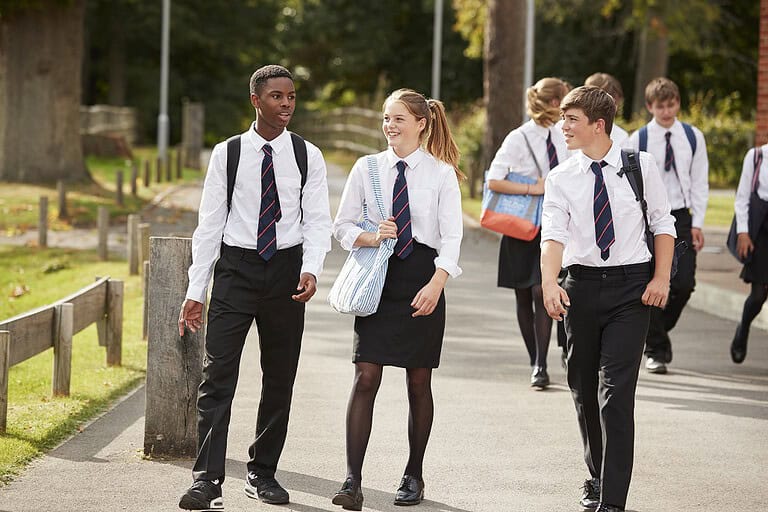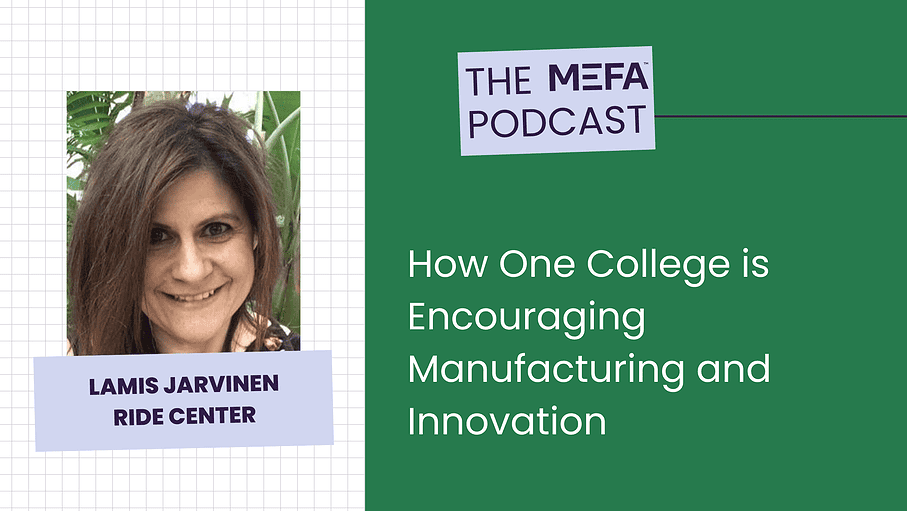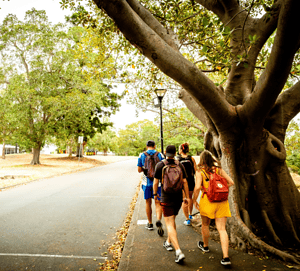Resources Mentioned in this Episode
Jonathan Hughes: [00:00:00] Hi everyone and welcome to the MEFA Podcast my name is Jonathan Hughes. Today’s show is a bit different. We’re going on location to Westfield State University to talk about the newly opened. Research Innovation, Design and Entrepreneurial Center, or the ride center. We spent the day out in Western Mass to talk to the creator of the center, Lamis Jarvinen, and some students using the center to create products.
So you’ll learn more about this new resource for students at Westfield State and surrounding high schools and how it fits in and hopes to sustain. Empower manufacturing and innovation in Western Massachusetts along with every student’s entrepreneurial spirit. So if you’re listening, and I’m glad that you are, [00:01:00] the video of this podcast, as always is posted on our website.
And our YouTube channel. And if you’re so inclined, I recommend that you watch this episode to get the full experience of the place of the tools and resources, and of course the people at the center of it. That’s all for me for now. I’ll be back at the end of the show, but now let’s go to the ride center and meet our guests.
Lamis Jarvinen: So my name is Lamis Jarvinen. I am the Executive Director of our Research Innovation Design and Entrepreneurial Center, also known as RIDE at Westfield State University. So a big vision mission statement for the Ride center is to provide access to tools and technology that. That accelerate and elevate the learning and to be able to provide [00:02:00] opportunities for any and all students to have a kind of a partnership in the design process and also the entrepreneurial process as they go on into their careers.
Jonathan Hughes: Is this the first center of its kind that you’re aware of?
Lamis Jarvinen: So it’s the first center of its kind that I’m aware of in terms of intentionality, right? So a lot of the tools that you could find in different.
Kind of fabrication design maker spaces that are on other campuses. What is different about it is that, I have a whole host of different tools than you would normally find, but I, the important part is that it’s intended and intentional in its goal of making sure it’s accessible to any and all students and to really work very collaboratively to focus not only on.
The design aspect, but on the entrepreneurial aspect, Westfield State had gotten or [00:03:00] received funding from the state to renovate Parental Hall, which is one of the oldest buildings on campus. And one of the focus for that is for student engagement and success, but also having Westfield Act as a hub of innovation and innovative, processes in our area. I was fortunate enough to have the opportunity. To work with the architects to design the space and work with really some fantastic collaborators to outfit it.
Jonathan Hughes: Here Lamis shows us what kind of equipment the center is outfitted with.
Lamis Jarvinen: That is a glass cutter over here. Yeah. Glass cutter and glass grinder. It’s a, it’s a really neat tool. The laser cutter is an incredible piece of equipment because it can, it’s a very precise cutting tool. Obviously it uses a laser beam and it can. It can cut, it can engrave anything from wood to cardboard, to leather, to [00:04:00] acrylic glass fusion kiln.
So this allows for glass, which has a coefficient, so it allows glass with the same coefficient to be melded together.
Jonathan Hughes: Ride center’s focus on innovation and entrepreneurship reflects the personality of its founder.
Lamis Jarvinen: I have a doctorate in molecular and cellular immunology as it pertains to organ transplantation tolerance. I’m an entrepreneur in the sense that I have started a couple of businesses. One of them was actually in the food industry. I made artisan hummus. I got picked up by Whole Foods, and I got to the point where I had to make a really difficult decision of do I want to open up a factory? Or, so it’s a good problem to have, but it’s also an interesting problem.
So that’s one of them. And then the other is as consultants, STEM consultants. So I think as a scientist, I’ve always had the. The opportunity to go into a [00:05:00] laboratory space, to have an idea, to be able to prototype it essentially to test it out, to test out these ideas and to better understand how things work, why they work the way that they do.
And that’s not necessarily the case for a lot of fields. So as I continued to work with undergraduates, it became very clear to me that what we need to do as educators and a scientist, is provide them with opportunities for applied experiences and not in the traditional ways that we might normally do it.
Meaning that you don’t have to go out and get an internship, or you don’t have to go out and get a, a 10 week summer research experience. But are there ways that our students can participate in their field of study to better understand it and better be able to be thought leaders in, in that area?
And I really wanted a space where students, regardless of whether they’re. Art students, science students, whatever it may be, they have a [00:06:00] space where they can take an idea and learn how to take it apart, work with others from a variety of different fields, and be able to come up with really creative solutions to complex problems.
And so hence the Ride Center. I think the space like this is generally associated with an engineering program, which we don’t have at Westfield State University, but. You don’t have to be an engineer in order to come up with an innovative or creative solution.
Jonathan Hughes: So who can use the Ride Center?
Lamis Jarvinen: The Ride Center is open to any and all students, regardless of whether this is their first semester here or their seniors during a capstone.
We really encourage. Non-traditional usage of this space. And some of the things that I’m trying to do is collect data to see who’s using it, what are they using, why are they here? And it’s fantastic. In a way you would predict that more stem science, technology, engineering, and math students would be using the space, but the data indicates otherwise.[00:07:00]
Jonathan Hughes: Let’s meet some of the students at the ride center to see if this bears out.
Mayelky Cordero: I’m Mayelky Cordero and I’m majoring in regional planning. I’m an English major with a marketing minor, so it’s not really in my wheelhouse to be doing things like this.
Alex Zajko: My name is Alex. I am the president of the Ride Club and a student ambassador for the Ride center.
Jonathan Hughes: And what do you study here?
Mayelky Cordero: Marketing and a minor in art. And what I do try to do is I try to. Give students. A better understanding of how the tools, the technology, and the way that you come at a problem in your field can help you think about what it means to be a thought leader, but also an entrepreneur.
Having a. An idea or having a good idea is one thing, but is it really a marketable idea? And so what’s the difference? And the other thing that I really work hard on is making sure that I have collaborators and [00:08:00] partners outside of the university that can continue to support our students, especially in the entrepreneurial realm.
There are a lot of fantastic organizations that. Do this very well, and it’s a matter of getting our students. Prepared and ready to work with those organizations or these corporations. We have a lot of private funders, donors, alums, corporate people who are interested in our students and wanna work with them.
And so it’s a matter of getting them to the step where they can take the idea out of their, essentially their dorm room and bring it to the market. I work with faculty to help them. Design opportunities that are course embedded that utilize this fabrication, these fabrication and design tools.
Jonathan Hughes: Here Lamis gives us an example of that embedded project within a course.
Lamis Jarvinen: You here? Yeah. This is from a graphic art topography course and the students we’re [00:09:00] challenged to create. Boxes and interactive material inside the boxes. And initially they had to do all of this by hand, and then they were brought to the ride center and they used the laser cutter to create these boxes and to create these different tools.
And so what it helps to teach the students is just the, I guess the precision of laser cutters and. How their ideas really fits into utilizing that tool. And so for example, this was one that a student made and has a little it’s a game of some sorts and then a little design.
But this one right here this is a really creative design, but I think that, if you had to sell this, it would be, as a consumer might be really difficult because the intricacies of the box design doesn’t make it [00:10:00] very easy to close. And so they, they learn a lot. How do you work with marketers?
How do you work with companies to design something that is very attractive and still. Consumer friendly. The other thing that I try to do is I created this tool Tuesdays, which are fun workshops. There are five of them throughout the semester. They take place on Tuesdays and there’s drop in between one to 4:00 PM Each one is focused on one particular or two fabrication or design tools for the students to get to know what they are.
How they work and then to make a fun DIY project that they can take back. So today’s tool Tuesday is focused on making a draw stringing bag, which doesn’t seem very complex or technological, but the students are learning how to use sewing machines and how to use cricket machines to personalize their bags.
How to use vinyl, how the software is required for. [00:11:00] Taking your idea, so you have an idea for example, for personalization. How do I turn that into iron on vinyl that I can actually use on my bag? And so what’s the software that goes with it? But what these workshops really do is they lower the the challenge that a lot of students have when they see a space like this.
It might. Look overwhelming or too technical or too technological, and they don’t know that it’s a space that’s really designed for them. It makes them feel comfortable. They, as a result, students come back as they’re thinking about other things that they have to do for classes and we get to know the students.
It’s a bit of an emotional social learning. And so just to slow down, but either way, the space, whether it’s through this, through courses, through personal kind of development, what they’re learning and what I’m telling them is that when you walk into a space like this, it’s very much different than all the [00:12:00] other tools, technology that you interact with during the day.
Like the phone, iPhone, you press a button and you get so much information in very little time. When you come here, it’s really slowing down. Understanding the tool, the software that goes with the tool, the materials that you need for the tool. And then how does your idea fit into all of this and how do you take something out of your head and make it in a way that can be communicated with others and articulate the importance of it.
So it’s really it’s a different way of thinking, right? So it’s breaking down a complex problem or a complex idea. In a way that you can create a prototype or something that’s tangible, that can express what it is that you’re trying to say. Yeah.
Jonathan Hughes: Do you find that students, because I am not a technical person, right? And so if I was. Told, Hey, there’s this new center where you can go and you can use a 3D printer or you can [00:13:00] use whatever and create something. I would think that’s not for me. Have you seen students come in with that attitude and really take to it?
Lamis Jarvinen: Yeah. No, absolutely. And I, and like I said, a lot of times these are intimidating, like 3D printers, they sound so technological, but then when you sit down and you explain to ’em.
How the machine actually works. Like literally it’s, you can think of it as a mechanical icing machine because all it’s doing is melting down a polymer to the coordinates that the design asks for. So that’s actually pretty straightforward. The design process actually happens well before then, and what I find is that the students are being asked to come here for a class, or they come in here because they’re.
They really want to try it out, and then they do. They realize that, you know what, it’s not as complex as I thought it was going to be.
Jonathan Hughes: Again, let’s check in with the students at the center.
Mayelky Cordero: I’m part of the ride club here, so [00:14:00] Alex actually recruited me and we came here for a tool Tuesday, a few weeks ago and we really fell in love with it here and we have a lot of fun.
Jonathan Hughes: And what are you working on?
Mayelky Cordero: I’m working on cutting out these little vinyls to go on the drawstring bags that we can, we press onto them. So I am working on the little nesters that go on them.
Jonathan Hughes: Is this for a course?
Mayelky Cordero: No, this is just for the event going on today till Tuesday.
Jonathan Hughes: And how long have you been coming to the RIDE Center?
Mayelky Cordero: I’d say like about a month. We just, it’s, I’m pretty new to here.
Jonathan Hughes: And you enjoy it though?
Mayelky Cordero: Yeah, I’m having a lot of fun.
Lamis Jarvinen: I think having students feel that when they’re in here, it’s not up to them to figure it out, but rather they have a lot of support. Every step of the way to help as little or as much as they want gives them kind of comfort and they realize that they’re actually good at this and they stay longer.
It’s nice for now. Overwhelmingly, I’d say about 80% of the students that show up are women. I. Part of it is a surprise to me. The other comments that I’ve [00:15:00] heard and none of it is really intentional is just being a woman and having an assistant who also happens to be a woman, lowers the barrier in terms of feeling like these tools and technologies don’t belong in our space.
Jonathan Hughes: Hey everyone, hope you’re enjoying the show. I want to take just one minute here. And say that if you like this show, if you’re into creating, if you’re an artisan who maybe lives closer to Boston, you may want to check out an earlier show that we did on the North Bennett Street School in Boston’s North End.
It’s sometimes described as America’s first trade school, and they offer courses on things like book binding, violin making, carpentry preservation, carpentry. Locksmithing jewelry repair, and more so for more information, check out the episode. Exploring trades at North Bennett Street School. Now back to the show, the right center is also available to neighboring high schools.
[00:16:00] And I talked to Lamis about that.
Lamis Jarvinen: We were talking about some of the high schools that come through here. For example, Westfield Technical Academy, which is just down the road from us, is a really impressive high school where they teach very technical skills. They have facilities that mimic, for example, tools that you would see in a precis, precision manufacturing or electrical or even aviation. And so a lot of their approach to this is learning very technical understanding of the tools that are utilized in that particular manufacturing process or aviation, whatever it may be. And.
What I love about working with. Those high schools and any high school really, but that particular, I’m going to use that particular one as an example, they came here for a visit and they were very interested in this space that, so despite the fact that they have all of these [00:17:00] millions of dollars of tools, they were still interested in this space because it comes at things in a different way than their focus.
Meaning that we’re. This space allows for a lot of different perspectives to come together to think through an idea and to actually apply. What does it mean to use that technical training of yours to solve a problem that. A client down the road may have, their focus is on training students to be job ready out of high school, so they’re highly technically trained in equipment and tools that are required, whether it’s for manufacturing or aviation or whatever it may be.
But we also want to create a pathway for our students. And what they tell me is that a lot of times the students that go to a technical academy are job ready, but they may benefit from continuing on. Through a college pathway [00:18:00] because of the theories and the conceptual understanding of the field that goes with being in a college setting.
And so I think that for them, they are, a lot of them are first generation students. And this is a great opportunity for them to take their technical training and to continue on with their educational experiences. And one of the things we’ve also been talking about is the importance of having them be exposed to what it means to be an entrepreneur.
Because if they. Whether they go on to college or don’t go on to college, a lot of them are going to be potentially running their own businesses. And so how do you get them ready without being a business major? So it’s not only an interest that the high schools have, but it’s also an interest our students have.
From speaking with them, we have a lot of corporate donors and funders who are very much interested in interacting with our students, coming to our space and having them be exposed. To their. [00:19:00] Their company and for our students to be leadership ready in their institution. So whether or not students go on to manufacture anything, what I think the right center allows them is the opportunity to better understand how the technology and the tools impact their field of practice and how to leverage that understanding.
To, drive their company into future directions that may not be anticipated. And what I mean by that is that, in Western Mass, the focus has always been our, in our economy, on healthcare, on education and on manufacturing. And so how do we support our students in preparing them for those jobs or even jobs of the future that we can’t, I.
Begin to conceptualize. So it would be fantastic if. Our students [00:20:00] become more comfortable and engaged in the idea, for example, of wearable sensors in healthcare, right? We have a large healthcare focus here, health science focus, wearable sensors, but that goes beyond healthcare.
It can go into forensic science, which is one of our biggest majors. How do we use. The tools and the technologies here to focus on creating wearables that, that will fulfill the needs of forensic science or military use or whatever it may be. Okay. So I just want to give an example of a tool like the cricket machine here, which is generally associated with arts and crafts.
And, students today are using it. Personalize their bags using vinyl. But because it’s such an incredible precision cutting tool, it can be used to cut, for example, filter paper that can go into a plate like a plate that’s 3D printed, for example, to have. Indicators for [00:21:00] forensic chemical analyses.
And so learning how to use this tool for something fun like DIY becomes less of an obstacle now when you’re asking students to create a field kit and having them figure out how to assemble very small pieces. And using the Cricut tool, now they’re comfortable with it. They can go in and they can apply it to something forensic or medical or whatever it may be.
Although these tools, you may think of them as arts and crafts, they really can go well beyond their intended use. And so that’s what I really like about them. I think the right center just hopefully serves as a true kind of manifestation of. If you’re given the opportunities and the tools, what can you do with them?
Jonathan Hughes: Thanks. Lae seems fitting that we should give the final word to one of the students.
Alex Zajko: I think it is a very useful resource on campus that I think every student should definitely visit. For sure.
Jonathan Hughes: All right. That was [00:22:00] our show everybody. My deepest thanks to Laise Jarin, and especially to all the students who generously agreed to appear on the show at a moment’s notice. We have information and links in the show notes about the ride center and folks, if you liked what you heard on the show today or what you saw on the show today and you want to know more from us about planning, saving, and paying for college and career readiness you can follow the show when you can do that wherever you get your podcasts.
And please leave us a review. It just helps us to keep doing what we’re doing and getting the show out to folks like you. In addition, I’d like to thank our producer, Shaun Connolly, Lisa Rooney, Lauren Danz, Meredith Clement, and AJ Yee for their assistance in getting the show posted. Once again, my name is Jonathan Hughes, and this has been the MEFA Podcast.













